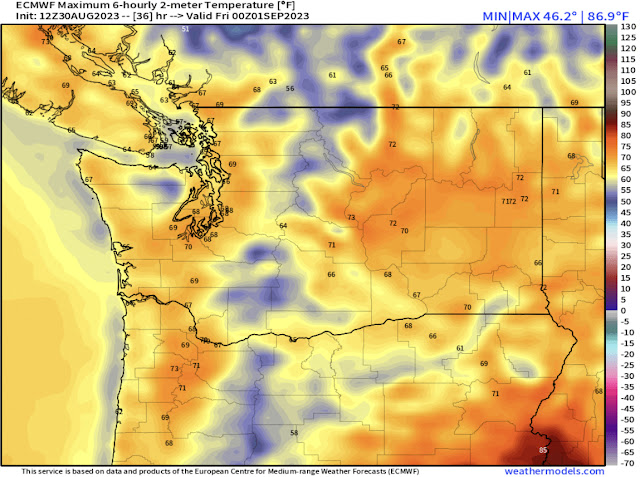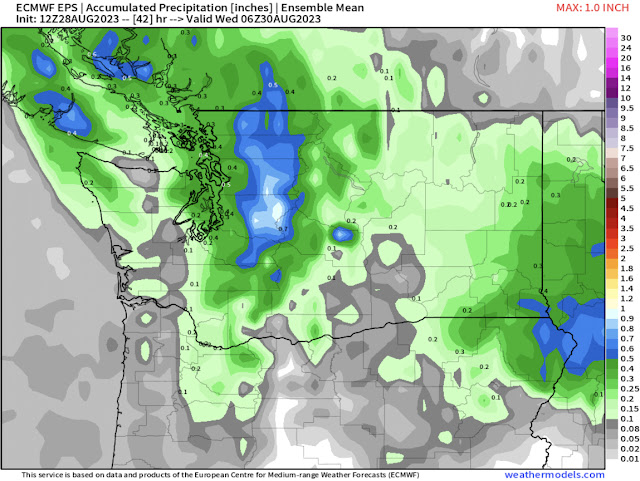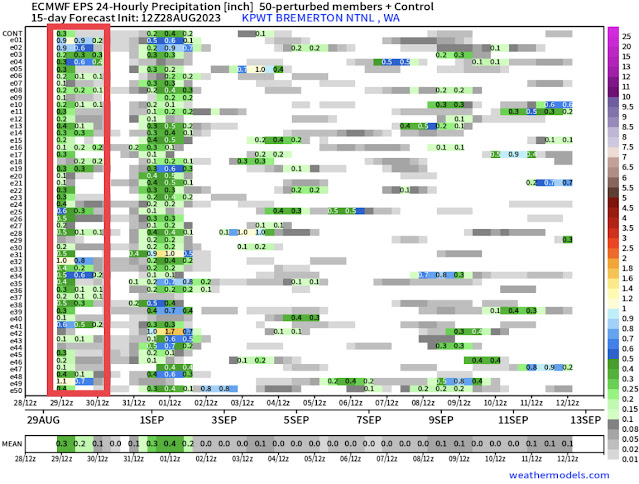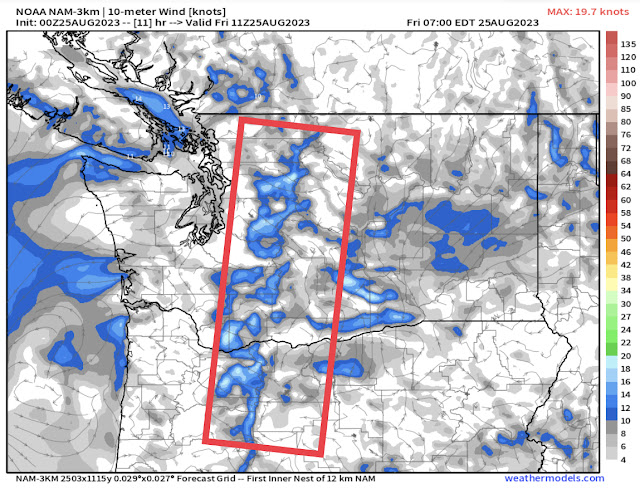FastCast—Thursday, Aug. 31 to Sunday, Sep. 3:
The next system is ahead for Washington state, with rain expected from late Wednesday night through Thursday. The lowlands will pick up 0.1-0.4”, with lesser amounts possible from Tacoma to Everett due to the Olympic rainshadow. Temperatures will be quite cool in the lowlands on Thursday, with highs only reaching the mid to upper 60s. Warmer conditions will arrive on Friday, with partly cloudy conditions and highs jumping to the mid to upper 70s. It will get hotter on Saturday, with mostly sunny conditions and highs reaching the low to mid 80s in the lowlands, before a dramatic cooldown to highs in the upper 60s to low 70s (with showers possible) on Sunday. Expect lows to remain in the upper 50s to low 60s.
——————————————————
Continue reading the full blog below!
The next weather system is ahead for Washington, bringing rain to most areas west of the Cascades from late Wednesday night through Thursday. After that, heat will build, peaking in the low to mid 80s on Sunday. Let’s take a look at the forecast!
First, we’ll take a look at the ensemble mean rain forecast from the European EPS model. This shows rain through Thursday night.
The EPS forecast shows 0.1-0.4” in the lowlands, with less around Seattle due to the Olympic rain shadow. Totals will be highest (0.3-0.5”) in the mountains, coast, and Willamette Valley, with areas from Tacoma south getting the most rain in the lowlands. In this forecast, Eastern Washington gets a trace to 0.2” of rain, except 0.3-1” from Spokane northward in the NE corner of Washington.
Next, we’ll look at the NAM high-resolution forecast, which shows far less rain than the European model (this is also through late Thursday).
The NAM shows a trace to 0.1” for most of the lowlands and Eastern Washington, with 0.2-0.5” on the coast. This does highlight a potential Puget Sound Convergence Zone feature, stretching from Bremerton toward Snoqualmie Pass, giving that area 0.2-0.4”.
Finally, the UW WRF high-resolution forecast, also showing rain through late Thursday.
The UW forecast shows a trace to 0.3” for the lowlands (least from Seattle to Tacoma), with a potential Convergence Zone from Seattle to Everett. The coast and areas from Olympia south toward Portland get the most rain, with 0.3-0.75”. In this forecast, Eastern Washington and the Cascades remain mostly dry.
The other aspect of the upcoming forecast is a relatively large increase in high temperatures over a few days. We’ll take a look at the European model forecasts showing temperatures on Thursday, Friday, and Saturday.
First, the forecast for highs on Thursday.
Expect Thursday's highs to be in the mid to upper 60s, with some readings in the low 70s, mainly in the Willamette Valley. The coast will reach the low to mid 60s, and Eastern Washington will have the coolest day in months, with highs in the upper 60s to low 70s.
Next, on Friday, temperatures will begin increasing across the state, seen below.
On Friday, with sunnier conditions, temperatures will climb to the mid to upper 70s (isolated low 80s) in the lowlands, the upper 70s to low 80s in the Willamette Valley, and the upper 70s to mid 80s in Eastern Washington. The coast will also warm up, with highs in the mid to upper 70s, except in the mid 60s at the ocean beaches.
Heat will peak on Saturday, with potentially the hottest conditions of September. The forecast for highs is below.
On Saturday, expect lowland highs in the low to mid 80s (same in the Willamette Valley), with Eastern Washington warming up even more to the mid 80s to low 90s. The coast will reach the mid 70s to low 80s, except in the upper 60s to low 70s at the beaches, a very nice September day!
As far as Labor Day Weekend goes, it won’t all be nice for Western Washington. Cloudier and cooler conditions, with a chance of showers, will return on Sunday. Below is the 15-day forecast for Seattle from the European Ensemble model.
Notice a spike on Saturday, with a dramatic decline to near-average conditions (highs in the upper 60s to low 70s) for the foreseeable future. Overnight lows will decrease from recent days, with lows in the low to mid 50s from Monday onward.
We’ll end by also taking a look at this same forecast for the Tri Cities, to show the outlook for Eastern Washington.
A similar trend can be seen for the Tri Cities, with temperatures peaking on Saturday, then dropping to seasonable levels for the foreseeable future.
Stay tuned for the forecast for Labor Day Weekend!



















































